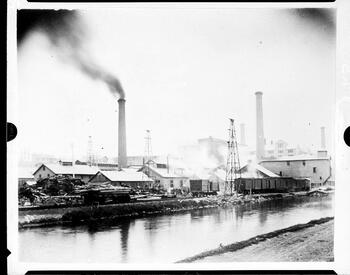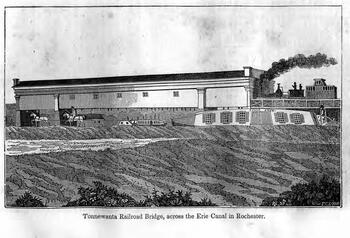There was also tremendous growth in non-agricultural industries such as lumbering and quarrying, as the Canal made the rich natural resources of the interior more accessible. The Erie Canal helped facilitate access to coal reserves in Pennsylvania, reducing American dependence on imported coal (mainly from Britain). Commercial logging commenced in the 1830s with the opening of the Erie Canal and is still a mainstay industry for both the US and Canada. In all of these industries, the increase in the volume of trade encouraged the rise of corporations through which people pooled their capital for larger investments and returns.
Ironically, the Canal’s tremendous success led to the rise of its ultimate competitor: the railroad. The Canal indirectly encouraged the creation of, and investment in railroads by enhancing access to iron, steel, and coal. Unable to keep up with the volume of commerce, the feeder canals were eventually supplanted by small railroad companies. In 1853, the consolidation of the several smaller railroads led to the creation of the New York Central Railroad that would dominate passenger travel and commerce until after World War I.
This photograph depicts the Solvay Process Industrial Plant in Solvay, New York. This plant was located on the Erie Canal, and this image shows lumber awaiting processing piled up on the Canal’s side. The rich natural resources of New York, including salt, lumber, and water were harnessed for many industrial purposes. Courtesy of Liverpool Public Library via Central New York Library Resources Council and Empire State Digital Network.
This illustration shows the Tonnewanta Railroad Bridge, which crossed the Erie Canal in Rochester, New York. Although they were often subsidized by federal and state funds, railroad companies, unlike the Erie Canal, were privately owned and not mandated to collect tolls for the freight they carried, making rail transport a more attractive option for businesses. Courtesy of University of Rochester Memorial Art Gallery via Rochester Regional Library Council and Empire State Digital Network.
Like the textile mills in New England, New York's Erie Canal promoted the rise of the market revolution, along with wage labor and factory conditions that impacted the lives of people, both socially and economically. This photograph shows Harmony Mills buildings along the Erie Canal. Courtesy of New York State Library via Empire State Digital Network.

